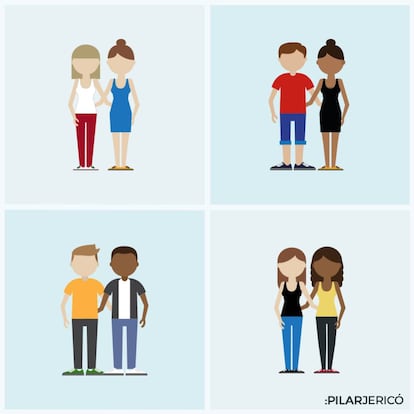If we knew more science, we wouldn’t judge people on their sexual orientation
A study from the University of Rochester suggests that homophobes are in fact rejecting their own tendencies
We continue to judge people with a different sexual orientation to our own, when science shows that sexual conduct is complex and full of possibilities. The challenge is to get to know ourselves better.

Our sexual behavior is far more complex than just the simple classification of hetero, gay or bisexual, as science has shown. In fact, our “beloved” tendency to label whatever is different to us is not correct, and can even be due to deeper reasons based on fear, as recent scientific studies have shown.
It all started with a biologist. It was 1948 and Alfred Kinsey swapped the microscope for interviews, speaking to 12,000 people, all of whom narrated their intimate experiences. Conclusion: 37% of men who took part in the study had, at some time, had some kind of homosexual experience, whether real or imagined. He published the results in a book, which became a best-seller but was also, perhaps unsurprisingly, the object of harsh criticism. And no wonder. Religion and ethics had been the order of the day in this area – for example, just a few years after, in 1952, the computer science genius Alan Turing was prosecuted for having relationships with other men.
Alfred Kinsey’s first step has led to countless scientific studies that show the wide variety of human sexual behavior
Alfred Kinsey’s first step has led to countless scientific studies that show the wide variety of human sexual behavior. Recent research shows that our pupils dilate when we are excited (try the test on your partner while he or she looks at different images). This was not easy to measure until recently, but Gerulf Rieger and Ritch C. Savin-William of Cornell University used an infrared scanner on the eyes of 325 volunteers while they watched erotic videos of men and women. Their conclusions are interesting: the first is that the pupils of bisexual men dilated to the same degree regardless of whether they watched men or women – that’s to say, they appeared to have no preference. Secondly, as was to be expected, heterosexual men showed stronger pupil responses to videos featuring women than those with men, although there was a response. That said, heterosexual women showed similar responses to both sexes. In short, there is a wide range of possible responses.
But despite science showing that we cannot easily classify what we feel or desire, we retain any number of obstacles and guilty feelings about diversity. In 2015, Pyschology Today was asked to stop advertising therapists that could “cure” homosexual tendencies. Perhaps if we knew more about what lay behind our rejection we could leave it behind. A study carried out by the University of Essex and the University of California in Santa Barbara analyzed four different studies carried out on a total of 160 people. It revealed a discrepancy between the sexual tendency people expressed and what they really felt. The conclusion is revealing: in reality, homophobes are rejecting their own sexual tendency. Repression in the home, education and what we “should” and “shouldn’t” feel had conditioned them and led them to hate their own tendencies.
In short, sexual conduct is complex, difficult to classify and anything that prevents us from recognizing the diversity of others, as well as our own, is going to hold us back. Rather than judging others, it might be worth asking ourselves how we feel when we see others who are different to us. Until we start looking inside ourselves, we’re going to find it hard to progress. And until that happens, we can only hope that science continues to provide data to convince the skeptics.
English version by Nick Lyne.
Tu suscripción se está usando en otro dispositivo
¿Quieres añadir otro usuario a tu suscripción?
Si continúas leyendo en este dispositivo, no se podrá leer en el otro.
FlechaTu suscripción se está usando en otro dispositivo y solo puedes acceder a EL PAÍS desde un dispositivo a la vez.
Si quieres compartir tu cuenta, cambia tu suscripción a la modalidad Premium, así podrás añadir otro usuario. Cada uno accederá con su propia cuenta de email, lo que os permitirá personalizar vuestra experiencia en EL PAÍS.
¿Tienes una suscripción de empresa? Accede aquí para contratar más cuentas.
En el caso de no saber quién está usando tu cuenta, te recomendamos cambiar tu contraseña aquí.
Si decides continuar compartiendo tu cuenta, este mensaje se mostrará en tu dispositivo y en el de la otra persona que está usando tu cuenta de forma indefinida, afectando a tu experiencia de lectura. Puedes consultar aquí los términos y condiciones de la suscripción digital.
More information
Archived In
Últimas noticias
From Andorra to Gibraltar, a black market for Ozempic exploits its success: ‘They’re the most sought-after products in the world’
Magnets in their heads: How some animals guide themselves using the Earth’s magnetic field
From Hungary’s Orbán to Chile’s Kast: How Trump helps turbo charge the far right
The brief rise and retreat of Generation Z in Mexico
Most viewed
- Why we lost the habit of sleeping in two segments and how that changed our sense of time
- Trump’s obsession with putting his name on everything is unprecedented in the United States
- Charles Dubouloz, mountaineering star, retires at 36 with a farewell tour inspired by Walter Bonatti
- Venezuela faces its most tense Christmas yet
- The Florida Keys tourist paradise is besieged by immigration agents: ‘We’ve never seen anything like this’










































